SUMMER MEANS BLUEYS!
Rhodey and Dizzy, from All The Gear But No Idea, outline the best ways to catch and cook a load of big blue swimmers this season.
Summer in SA is when the state’s recreational fishing really starts to kick off, and there are few better species to target than blue swimmer crabs. The variety of ways to catch them, the quality on the plate in different forms, and the excitement of catching them are just some of the reasons we love a feed of crabs as the weather warms up.
There is an old anecdote in South Australian fishing that you can target blue swimmer crabs in any month with an ‘r’ in it. This means we usually start to see them show up in September and October as they move into shallower water to spawn. Having said that, we usually find the best fishing for blueys happens in November-February, when the hot weather is really upon us and the crabs are actively feeding in shallower water.
Blue swimmer crabs can be targeted in many different ways, which makes them such a great species to fish for in the warmer months. Our personal favourite is dropping pots off the boat, and we love doing that with family and friends; it really is a great social day’s fishing. Most tackle stores will sell drop nets that are made of two simple steel rings, with a steel mesh bottom and some netting which connects the smaller bottom ring and the larger outer ring. These nets are then connected to a rope, which you can tie to the front of the boat if you are staying stationary while you target whiting or garfish off the back. Alternatively, they can be connected to a white buoy of at least four litres in size. A tag with your name and address are mandatory if you are leaving your pots unattended in the water. You can fish with three drop nets per person, and they do not need to be registered.
Another piece of crucial equipment is a crab measurer, whether fishing on the boat, jetty or raking, which can be bought at any tackle shop. The minimum legal size in SA is 11cm, measured from the base of the longest spine on each side of the carapace. If the measuring device can fit over the crab’s body at this point, the crab is under size. Male and female blue swimmer crabs can both be kept, however it is important to check the female crabs for eggs. If they are carrying eggs, they must be returned to the water safely as soon as possible. The gender of the crab is particularly distinguishable by the colour and the underside of the crab. The male is a much darker, deeper blue than the female, with the male also having a much narrower abdominal flap on its underside.
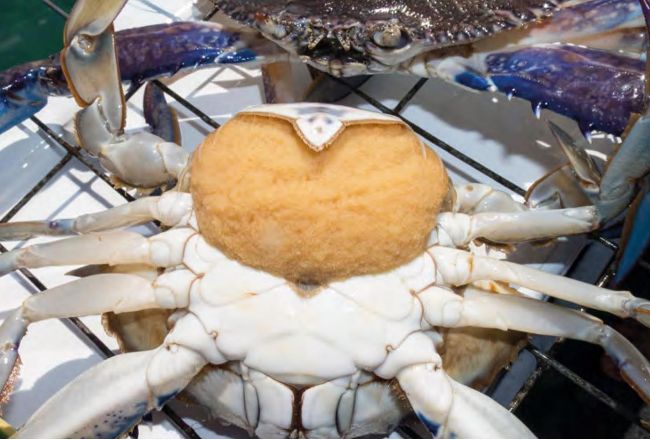
Female blueys can produce millions of eggs. They have to go back
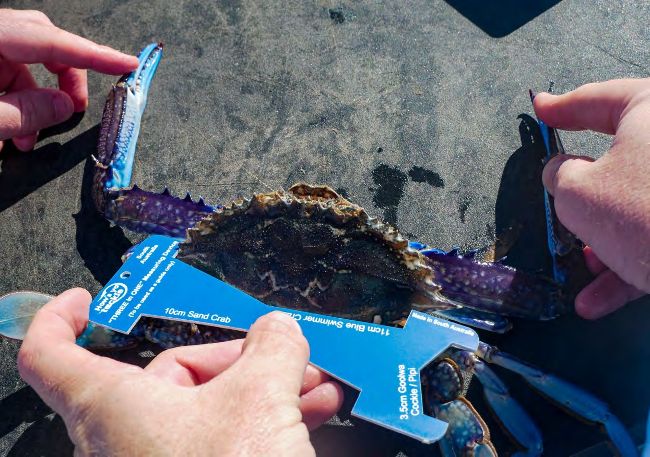
This crab makes the grade easily
The best way to bait a crab net is to use a mesh bait holder or cage attached to the base of the net, which stops the crabs from simply biting off the bait and escaping. Common baits include King George whiting heads, squid heads, carp cutlets, and any other oily fish frames. For us it is often fish frames and heads after taking the fillets off for dinner, or any old bags of pilchards or similar oily baits that have been taken out for a day’s fishing and returned a bit mushy and defrosted.
When dropping in your nets, it is important to make sure the base of the net stays vertical and lands flat on the water, ensuring it will sink straight down and sit flat on the bottom. Occasionally, when less experienced crabbers are throwing in the net, it can land on a bit of an angle, and it is often difficult to tell if the net has ended up sitting flat or flipping over with the bait outside the net. The other obvious thing to be mindful of when setting or retrieving drop nets is that outboards and rope do not mix, so make sure to throw the buoy well away from the boat as the net is sinking. The skipper also has to be on his game and keep the motor well away from the rope. It is often best to approach from the downwind side and collect the buoy first before motoring up alongside the rope.
In terms of where to set the net, we find you are best to position the net on sandy bottom, but as close as possible to the weedline. This ensures the net isn’t going to get caught up in the weed, enabling the crabs to escape, but also means it is close to weed where the crabs tend to hide. Often, smaller white holes amongst the weed can be your best bet.
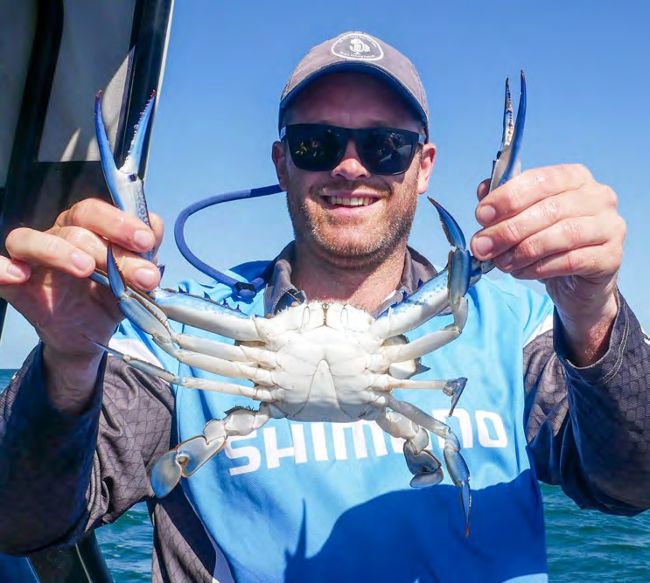
The safest way to hold any big crab
When using multiple drop nets, it is crucial to ensure the baits are left to soak on the bottom for sufficient time to allow the crabs to find them. We find that at least ten minutes is a good starting point, and if you are unsuccessful, leaving for longer can sometimes result in better catch rates before deciding to leave the area and try somewhere else.

Pull the rope quickly and steadily
Drifting for squid, fishing some nearby white holes for whiting or just floating and having a cold drink can be great ways to pass the time while waiting to pull the pots. When the time does come to retrieve the pots, it is crucial that you don’t disturb the pot before pulling it into the boat. The best method for this is pulling in the slack line slowly until you get closer to the pot, then quickly and with consistent pressure pulling the pot into the boat to ensure the sides of the net stay up nice and high and the blueys can’t escape.
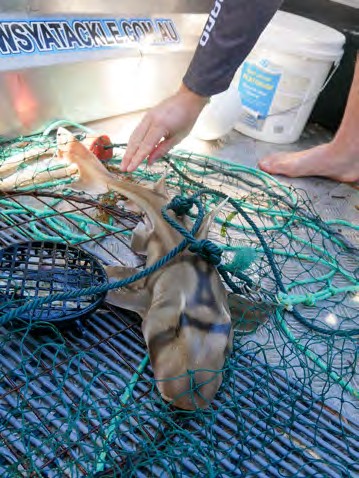
Be prepared for some by-catch
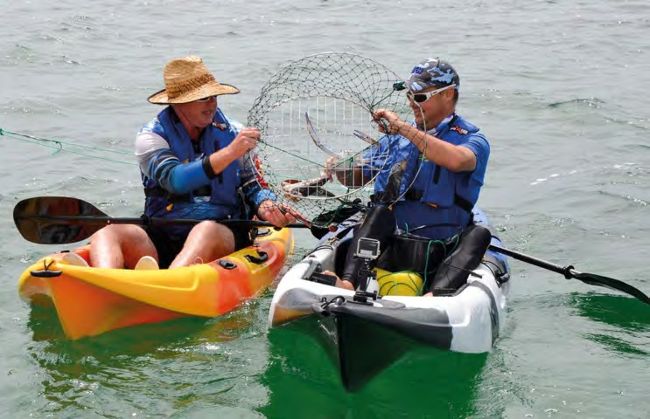
Crabbing from kayaks is a lot of fun
Once you get the net into the boat, the fun begins. The crabs will often clamp down with their claws onto whatever metal or netting they can find, or wriggle around and get the net caught around their legs. Both of these make it tricky to get them into the ice box without getting bitten. When removing one claw from the net, keep a good eye on the other one, as a bluey can often have a crack at you with the unattended claw. For this reason we often find it best to grab onto one claw in each hand before trying to remove them. If the crab is away from the net, or if it isn’t grabbing onto anything it can find, you can also pick them up from the base of the ‘swimmer leg’, where they can’t quite reach with their claws. Watching a less experienced mate try to get the blueys into the ice without getting nipped is often a true case of “All the Gear But No idea”, and very amusing for all involved.
Kayak fisho’s often target crabs using drop nets in similar shallow water using much the same technique. Obviously, with less space and stability on a kayak compared to a boat, you need to be careful when retrieving the nets and, hopefully, taking the crabs out —always a bit more hectic when working in the close confines of a kayak. As with any kayak fishing, it is also worth thinking about where you can store an ice box in easy reach to stash your catch, and also where the nets can be positioned while paddling in/out from the beach. It is also worth being organised with ropes untangled and your nets baited up before paddling out, to ensure a smooth deployment of your nets.
Another great thing about crabbing is the ease with which land-based anglers can get involved. On a nice day in summer many of the jetties across the state will have a rope and crab net every 10m along both sides of the jetty. Crabbing off the jetty is much the same as in the boat, with people generally tying the rope to the railing instead of a buoy. The only real downsides are the inability to move around as much if the crabs are not about that area, and the high density of crab nets off busy jetties lowers your chances of catching a big feed.
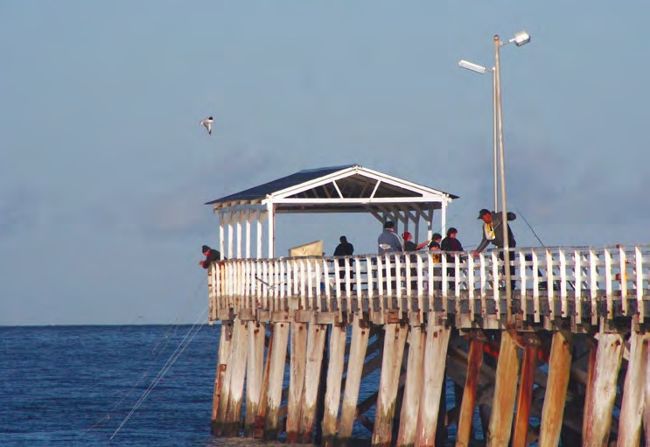
Most metro jetties produce plenty of crabs in the warmer months
Sometimes there can be a resident seal hanging around and taking advantage of an easy feed by attacking your crab net. To overcome this, many people theorise that the seal won’t attack a flathead frame, as they have learnt to avoid their sharp spines on the back of their head. Refreshing your baits can often be a good option to get the scent out further, which will attract the blueys closer to your pots and yield a better catch.
Another popular method for targeting blueys is raking for them. Raking for blueys can be a lot of fun, and a little bit of preparation will go a long way to ensure you come home with a good feed without too much hassle. Firstly, you’ll need a crabbing rake that can be purchased at any tackle store. Secondly, you need to make sure you have something to put your catch into when you find the crabs. We find the most convenient way to store your catch is by tying a rope to a tub with a pool noodle or some floats to keep it suspended while it drags along behind as you search through the shallows.
A good set of shoes or waders will make sure your feet don’t get nipped by blueys or you step on a sharp razorfish as you search the shallows for them. Now the fun begins; take your rake and scratch through the shallow weed beds in search of some blueys. Again, we find the edges of sand and weed tend to be where you’ll find them. They also like to bury themselves in sand at low tide and can sometimes be found under small mounds of sand, so it’s worthwhile disrupting the surface of these mounds to see what lies beneath. Once you find a crab, the challenge is then to trap the crab with the rake and get it into the tub. The bluey will usually grab onto the metal end of the rake as you trap it, which allows you to remove the crab from the water and check it for size. This method can prove a lot of fun and will often yield great results, particularly as the tide starts running in from the bottom of the low in areas where there is shallow water and broken bottom of weed and sand.
There really are heaps of locations around the state to target blue swimmer crabs. They can be found all along our metropolitan coast, and they can be regularly spotted in the shallows when you’re swimming or wading. The abundance of crab nets tied onto local jetties is a giveaway that they are about. There probably isn’t a lot of difference from one jetty to the next, with Grange, Glenelg, and Brighton all great places to start.
For crabbing off the boat, the whole metro coastline has plenty of crabs in shallow water, with consistent catches found anywhere north of about O’Sullivan Beach. If you prefer to rake for them, or if you are willing to travel a bit further, Thompson Beach would probably be the pick, with nice shallow flats at low tide, sandy patches amongst the weed, and plenty of tidal movement all making it a great crabbing location.
The Yorke Peninsula also has some excellent locations to target crabs, including many of the beaches across the northern half of the peninsula. Ardrossan, Pine Point and Tiddy Widdy Beach are particularly famous for crabbing and only a couple of hours from Adelaide. In recent years the blue swimmer crab has been appearing more and more in American River on Kangaroo Island, which is interesting, as the blueys haven’t traditionally been found there. Potentially, an increase in water temperature over recent years could be the reason for this, with crabs preferring the warmer water. This is why crabs are rarely seen across much of the Fleurieu Peninsula, the State’s South East and the bottom end of Yorke Peninsula, with crayfish preferring these colder waters.
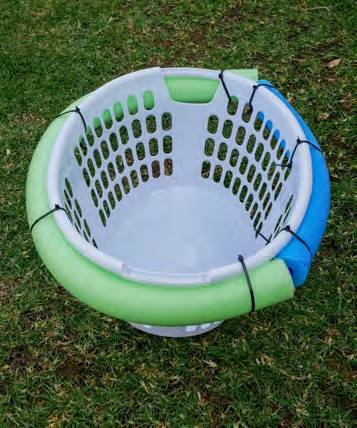
DIY - cheap and simple
Now that you have caught yourself a good feed of blueys using any of the methods outlined above, it’s time to cook and clean them. Blueys have a delicious flesh that, when cooked right, is very enjoyable on a summer’s day with a few cold beverages. However, it is very versatile and can be cooked and enjoyed in many different ways. The most common way to cook blue swimmer crabs is in boiling salt water. There are many crab cookers on the market to make this a lot easier if you fish for them regularly. Fill the pot up with salt water and bring it to the boil. Once the water is at a rapid boil, you can drop the blueys in, one by one. The crabs will immediately turn bright orange, and once the water is back to the boil, you want to turn the heat down and simmer for a further six minutes for average sized crabs. After the cook is finished, the crabs need to be quickly removed and placed into an icy saltwater slurry to stop the cooking process. From here you can begin to clean the crabs, place them in the fridge for a few hours to let the meat set, and then they are ready to enjoy.
Other blue swimmer recipes include chilli crab and crab pasta, with hundreds of recipes around for both of these dishes. Some will require you to pre-cook the crabs as outlined above, while others will have you start with raw crabs (often cut into pieces) and cooked in a sauce.
Catching blueys is a fantastic form of fishing leading into and throughout the summer months, with many different ways to target them. We hope you’ve found the article useful for some tips and you manage to catch a feed. We always recommend having all the gear with a bit of idea so you can successfully catch a feed of this lovely species and enjoy some time on the water with friends and family!
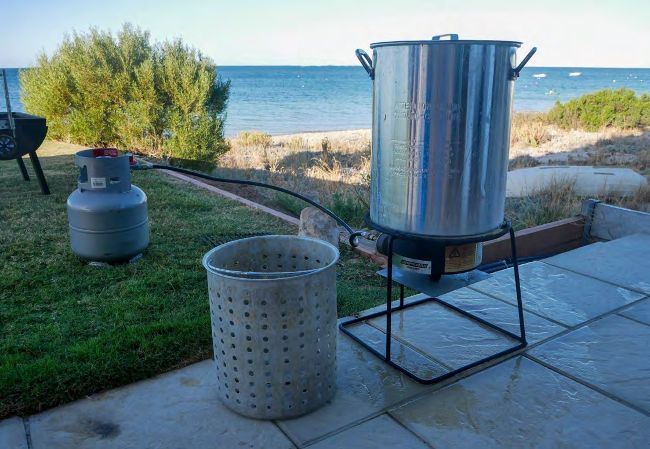
Preparation is key to cooking crabs successfully